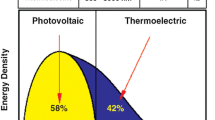Abstract
A possible approach to raise the efficiency of single-junction solar cells is to couple them with thermoelectric generators (TEGs). It was shown that TEG contribution to the output power is basically ruled by the characteristics of the photovoltaic (PV) material. In this study, we present a quantitative model that correlates the efficiency of the hybrid thermoelectric–photovoltaic (HTEPV) device with the energy gap and the working temperature of the solar cell. Two HTEPV structures are discussed, one capable only to recover the heat released by relaxation of hot electron–hole pairs; and a second one also capturing the low–energy part of the solar spectrum. We show that in the second case the increase of the conversion efficiency could justify the effort needed to add a TEG stage to the PV device. HTEPV constructions are also shown to enable the use of wide-gap materials that are not currently considered in PV applications.





Similar content being viewed by others
References
W. Shockley and H.J. Queisser: Detailed balance limit of efficiency of p-n junction solar cells. J. Appl. Phys. 32, 510 (1961).
T.T. Chow: A review on photovoltaic/thermal hybrid solar technology. Appl. Energy 87, 365 (2010).
D. Kraemer, B. Poudel, H-P. Feng, J.C. Caylor, B. Yu, X. Yan, Y. Ma, X. Wang, D. Wang, A. Muto, K. McEnaney, M. Chiesa, Z. Ren, and G. Chen: High-performance flat-panel solar thermoelectric generators with high thermal concentration. Nat. Mater. 10, 532 (2011).
B. Parida, S. Iniyan, and R. Goic: A review of solar photovoltaic technologies. Renewable Sustainable Energy Rev. 15, 1625 (2011).
K-T. Park, S-M. Shin, A.S. Tazebay, H-D. Urn, J-Y. Jung, S-W. Jee, M-W. Oh, S-D. Park, B. Yoo, C. Yu, and J-H. Lee: Lossless hybridization between photovoltaic and thermoelectric devices. Sci. Rep. 3, 2123 (2013).
N. Wang, L. Han, H. He, N-H. Park, and K. Koumoto: A novel high-performance photovoltaic thermoelectric hybrid device. Energy Environ. Sci. 4, 3676 (2011).
B. Lorenzi, M. Acciarri, and D. Narducci: Analysis of thermal losses for a variety of single-junction photovoltaic cells: An interesting means of thermoelectric heat recovery. J. Electron. Mater. 6, 1809 (2014).
J.L. Gray: The physics of the solar cell. In Handbook of Photovoltaic Science and Engineering, L. Antonio and H. Steven eds.; John Wiley and Sons Ltd: 2003; pp. 61–111.
G. Friesen, D. Pavanello, and A. Virtuani: Overview of temperature coefficients of different thin film photovoltaic technologies. In Proceedings of the 25th European Photovoltaic Solar Energy Conference & Exhibition—5th World Conference On Photovoltaic Energy Conversion, 2010; pp. 4248–4252.
T. Nordmann and L. Clavadetscher: Understanding temperature effects on PV system performance. In Proceedings of the 3rd World Conference On Photovoltaic Energy Conversion, Vol. 3, 2003; pp. 2–5.
E. Skoplaki and J.A. Palyvos: On the temperature dependence of photovoltaic module electrical performance: A review of efficiency/power correlations. Sol. Energy 83, 614 (2009).
ASTM G113-03: Standard Tables for Reference Solar Spectral Irradiances: Direct Normal and Hemispherical on 3T Tilted Surface (ASTM, West Conshohocken, PA, 2012).
D.K. Schroder: Semiconductor Material and Device Characterization (Wiley-Interscience, New York, 1998); pp. 422–427.
S.M. Sze: Physics of Semiconductor Devices (Wiley, New York, 1981); pp. 793–798.
Y.Q. Cao, X.B. Zhao, T.J. Zhu, X.B. Zhang, and J.P. Tu: Syntheses and thermoelectric properties of Bi2Te3Sb2Te3 bulk nanocomposites with laminated nanostructure. Appl. Phys. Lett. 92, 143106 (2008).
B. Poudel, Q. Hao, Y. Ma, Y. Lan, A. Minnich, B. Yu, X. Yan, D. Wang, A. Muto, D. Vashaee, X. Chen, J. Liu, M.S. Dresselhaus, G. Chen, and Z. Ren: High-thermoelectric performance of nanostructured bismuth antimony telluride bulk alloys. Science 320, 634 (2008).
X. Yan, B. Poudel, Y. Ma, W.S. Liu, G. Joshi, H. Wang, Y. Lan, D. Wang, G. Chen, and Z.F. Ren: Experimental studies on anisotropic thermoelectric properties and structures of n-type Bi2Te2.7Se0.3. Nano Lett. 10, 3373 (2010).
ACKNOWLEDGMENTS
This work was supported by FP7-NMP-2013-SMALL-7, SiNERGY (Silicon Friendly Materials and Device Solutions for Microenergy Applications) Project, Contract no. 604169.
Author information
Authors and Affiliations
Corresponding author
Rights and permissions
About this article
Cite this article
Lorenzi, B., Acciarri, M. & Narducci, D. Conditions for beneficial coupling of thermoelectric and photovoltaic devices. Journal of Materials Research 30, 2663–2669 (2015). https://doi.org/10.1557/jmr.2015.174
Received:
Accepted:
Published:
Issue Date:
DOI: https://doi.org/10.1557/jmr.2015.174



